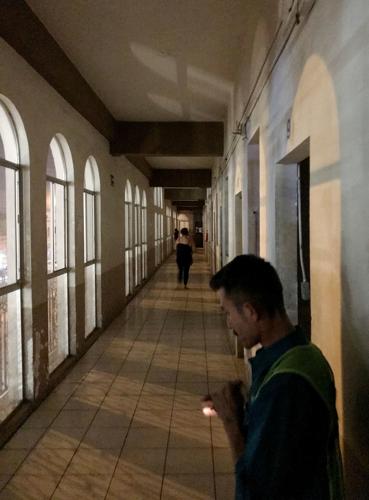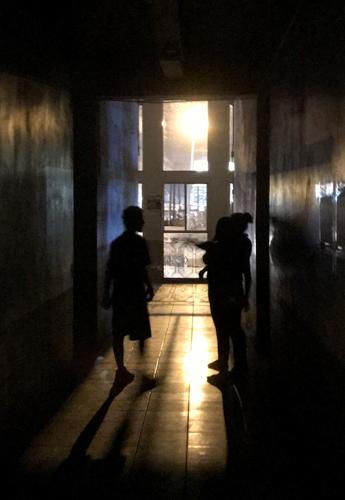Tim Steller is the Star’s metro columnist. A 20-plus year veteran of reporting and editing, he digs into issues and stories that matter in the Tucson area, reports the results and tells you his opinion on it all.
MEXICALI, Baja California —
It took a hell of a struggle for Kenia Dávila to make it from Honduras to this Mexican border city.
Threatened by criminals who were after her husband, Dávila fled with two children, ages 11 and 13, early in 2019, she said. They were chased into Guatemalan territory and had their papers stolen, Dávila recounted, but made it into Mexico. Indigent, she and the kids hopped freight trains, slept by the tracks, and, weeks later, finally made it to the border at Mexicali.
That was six months ago.
Now she’s going back to Honduras.
Thousands of Central Americans rushed north earlier this year, some making it into the United States as they pursued asylum claims, hoping that bringing children would allow them to stay in the USA. But in recent months migrants are finding it harder to get into Mexico’s interior, let alone make it to the United States and request asylum in U.S. courts.
President Trump wants it that way, and his administration’s harsh policies seem to be working.
I met Dávila, 32, and dozens of others on a weeklong trip to Baja California, stopping in Mexicali and Tijuana before spending some time in San Diego’s immigration court. This reporting trip was part of my project, funded by a Society of Professional Journalists Foundation fellowship, that is focused on how politicians try to mold public opinion about the border and migration.
But the story I’m telling here today isn’t launching my series about public opinion so much as describing the harsh reality that has taken hold just across our border. The ironically named Migration Protection Protocols mean people are having to endure months in Mexican border cities, many in primitive shelters or tent cities, just to get a chance at proving an asylum claim.
More than 55,000 had been thrown back to await their court hearings as of Oct. 28, the Department of Homeland Security reported.
These days, some never make it this far north, as Mexican authorities block them from crossing at the Guatemalan border and keep others from leaving the southern border state of Chiapas. Others, like Dávila, make it to Mexico’s north but eventually give up.
Now the Migration Protection Protocols program has finally come to Southern Arizona. The Department of Homeland Security confirmed Nov. 22 that it will begin busing some asylum seekers who show up in the Border Patrol’s Tucson sector to Ciudad Juarez, Chihuahua, where they will be forced to stay while they wait to make their court appearances in El Paso.
Eerie nights at shelter
When Dávila fled Honduras, things were different. It was spring, and people from Central America were fleeing across the U.S.-Mexico border, turning themselves in to Border Patrol en masse and being released into cities like Tucson. We took care of them here, at the Benedictine Monastery and other shelters, before they were sent off to other U.S. cities to have their asylum cases judged.
While Trump and his supporters wanted to stop the “catch and release” of people who crossed the border between ports of entry and turned themselves in, they also wanted to minimize the number of people being admitted at the ports of entry to request asylum.
Port officials have been “metering” these entries by only admitting a small number per day at ports of entry, which in effect means discouraging applications and encouraging giving up.
Dávila and her two children got stuck in Mexicali. I met her on the second floor of a shelter that has become famous in border migration circles, the Hotel del Migrante in the old downtown. It’s an abandoned hotel that was damaged in an earthquake and repaired enough to house migrants. They charge 30 pesos per night, or about $1.66 at today’s exchange rate.
My first visit was at night, and the downstairs was recognizable enough, with rows of bunk beds in a large lit room. But upstairs the scene was spooky. Imagine rows of hotel rooms with no doors in the frames, no glass in the windows, and no lights. Only the outside lights of downtown Mexicali illuminated the second floor.
Families and other residents murmured behind curtains made of blankets, towels and clothes hung in the doors and windows. Dávila and her children were staying in one of the rooms I walked past that night, but I did not meet them till the next day, when the daylight washed away the eeriness and residents moved through the halls.
When the family got to Mexicali, Dávila explained, “We jumped to the other side of the border, and when we arrived on the other side, immigration caught us and put us in the icebox for 12 days.”
The “icebox,” or “hielera,” is the nickname for Customs and Border Protection detention centers where temperatures are typically kept uncomfortably cold. She requested asylum but was sent back across the border to Mexicali, as part of the Migrant Protection Protocols.
There’s no immigration court across the border in nearby Calexico or El Centro, California, so asylum seekers who have court dates are bused the day before, by the charity group Border Kindness, to Tijuana.
They stay in a hotel one night and get up early the next morning to be taken across the border to court, where each asylum seeker’s first couple of hearings typically consist of migrants asking for attorneys and explaining how they’re trying to find them.
“We went to court three times and lost twice,” Dávila said. “Finally, we couldn’t go because we didn’t have money to pay for a lawyer.”
“They told me that if we don’t have papers that are sealed and signed, we can’t cross and they were going to deport me to Honduras. You know that a poor person can’t afford an attorney.”
Months of waiting, without attorneys
I could not verify the details either of Dávila’s story of fleeing from Honduras or of her treatment in court. But I can verify that the hunt for an attorney is a constant, largely vain struggle for those who wait in the shelters and camps of Mexico’s border cities.
Immigration Judge Lee O’Connor, of San Diego, has become famous for railing against what he considers the illegalities of the Migrant Protection Protocols, terminating many cases as a result. But he is equally demanding of asylum seekers over their efforts to find lawyers.
I watched him demand, in some exasperation, details from asylum seekers of which law offices they had called, what the answering service said, in what language they spoke and whether they left messages.
His demands were in the spirit of accountability — he wants them to make real efforts and not waste the court’s time — but they suggested a lack of understanding of how these people are living across the line.
Staying in shelters in Tijuana or Mexicali, many sleep little and spend their days avoiding being robbed, raped or kidnapped. They may have phones, but cross-border connections can be sketchy, and their phone plans may run out.
Some migrants can get paying work occasionally, but they worry about leaving the relatively safe confines of the shelters, and especially of leaving children there.
That means that the one factor that increases their success in making an asylum claim —having a lawyer — is out of reach for most people but those with money. There are way too many clients for the pro bono clinics to represent them all at no charge.
So increasingly, at shelters like Hotel del Migrante, the residents from Central America give up and go home, said Isabel Gonzales, who manages the shelter.
“They wait three or four months for their first court date,” Gonzales said. “Then they’re sent back and have court in another month. And that way the people end up spending six months here. Some get tired of it and return to their home countries. They can’t be defraying their costs so much for one court appearance just to be sent back across.”
That’s the logic that caught up to Dávila, and of the program that she was caught in. When I left her in the second floor of the Hotel del Migrante, she said they didn’t have enough money to keep paying for the shelter.
“Why did we suffer? We suffered so much,” she said. “I’m scared to go back to Honduras, but if I can’t (cross the border) I have to go back to my country.”





